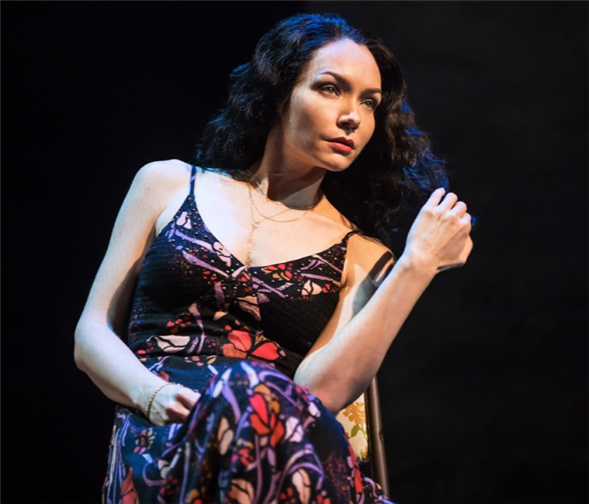Translate Page

How Patrick McCollum found the right moves for Broadway's The Band's Visit
---
How do you create choreography for a subtle story about human connection? That's what Patrick McCollum had to figure out when he was brought on to add movement to The Band's Visit, an intimate, character-driven musical about an Egyptian military band that gets stranded overnight in a small Israeli town. McCollum joined the creative team during the musical's Off-Broadway premiere at the Atlantic Theater Company, and he knew from the outset that conventional musical theatre dance wasn't going to work.
A choreographer who also has experience as a fight director and creative consultant, McCollum wanted to come up with naturalistic movements and elegant transitions that wouldn't pull focus from the narrative. He began working with the cast of actor-musicians -- some of whom had little dance experience -- when the production was already in tech rehearsals for the Off-Broadway run. But he wasn't fazed. "Lucky for me, over the past six years I've predominately worked with actors, so I was prepared," he says. "It comes down to a conversation with them about what I see a moment to be, as well as what they feel. I've found if I can give them clear visual descriptions they can tap into, like 'think of this moment like a cloud moving over a mountain,' the actual movement tends to work itself out."
McCollum also asked director David Cromer about his vision, and the two agreed that a sense of perpetual motion was the way to go. "I love making things flow, so it was a good fit for me," McCollum says.
{Image1}
He points to a time-lapse sequence at the top of the show as an example of how he shifted the transitions from functional to artistic. "There's a moment after the band arrives in the wrong town, and Dina [played by Katrina Lenk] invites them all to sit in her café as they wait for more information about a bus," he says. "When I started, it was all about just the task; it was missing any sort of zhuzh. So it was a matter of working with the actors. Rather than just picking up chairs and setting them down with a thud, I had them lift and lower with elegance, so that while the lights are tracing the sky from midday to sunset, the movement mirrors it."
Once the show transferred to Broadway, where it swept the 2018 Tony Awards, McCollum decided to expand a few numbers for the larger stage. Take "Omar Sharif," Dina's sensuous ode to the Egyptian movie star. As McCollum watched her slow hip dips and fluid, waving arms swirling like hookah smoke in the air, he realized he wanted other characters on stage with her. "On the big swells of the music, I added grace notes of movement, like the other café-goers mimicking what Dina is doing in a larger way," he explains. "I wanted it to look like what she's feeling is flowing out to everyone. There are very few moments of unison in the show, so we reserve them for big-ticket items like this."
{Image2}
For the show's most boisterous number, "The Beat of Your Heart," sung by a music-loving Israeli widower, McCollum met with Cromer and the actors to discuss how far they could go movement-wise without crossing into unrealistic territory. "Every Israeli has to do military service, so I wanted to tap into the type of physically grounded work that someone with army training might feel comfortable with," he says. "I found this number challenging because it required so much editing. I met with Andy Polk [who plays the widower, Avrum] at a gym in between productions. We came up with four counts of eight, but in rehearsal it was clearly too much, and it got edited down to just about one count of eight."
In addition to tailoring the choreography to the actors' abilities, McCollum says their study of the Israeli dance technique Gaga helped loosen them up physically and psychologically. Created by Ohad Naharin, the former artistic director of the Batsheva Dance Company, Gaga encourages investigation and discovery, with tasks and ideas serving as the basis for movement, resulting in raw and pure motions.
For the Broadway run, McCollum brought in Gaga legend Bobbi Jene Smith to teach classes to the cast. "For a lot of actors, how they appear is their currency," McCollum says. "Looking silly or being vulnerable requires a lot of walls being broken down. Bobbi Jene has an inherent way of being low-key and approachable. While Gaga sessions feel sort of out there, and it definitely takes about 10 minutes for the actors to let their guards down the first time, the way she instructs and encourages is disarming. By the end, everyone is smiling and sweating, clearly having done something magical. And that's what I appreciate about her: She taps into people feeling their own magic."
Currently, the cast members get Gaga sessions once a month, and McCollum says this helps them stay open on stage, whether they're dancing or simply inhabiting the show's world. "Gaga keeps people physically honest and makes them remember they're not just doing what's set on them," he says. "The potential to phone it in lessens greatly when you're able to remember who you are inside the movement."
---
Phoenix Lauren Kay regularly contributes to TDF Stages.
Katrina Lenk in The Band's Visit. Photos by Matthew Murphy.
The Band's Visit is frequently available at the TKTS Booths.
TDF MEMBERS: Go here to browse our latest discounts for dance, theatre, and concerts.